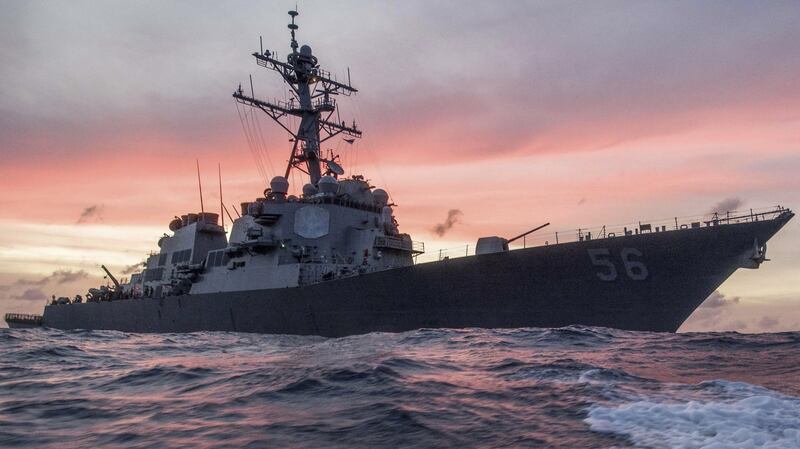When the top U.S. diplomat visited the Indo-Pacific last week, the White House unveiled a new strategy that vowed to use all “instruments of power” to anchor the United States in the region and counter what it called China’s pursuit of a “sphere of influence.”
Coming when the world’s eyes were on the standoff with Russia over its troop build-up on the border with Ukraine, the message was clear – that the United States views the Indo-Pacific as its foreign policy priority.
In Melbourne, U.S. Secretary of State Antony Blinken met on Friday with counterparts from Australia, India, and Japan – collectively known as the “Quad.” Then at the weekend, he travelled to Fiji, signalling U.S. intent to engage more with the Pacific islands. Moving on to Hawaii, he sat with allies South Korea and Japan.
As he did so, the Biden administration published a 19-page strategy document for the region that includes an action plan for the next 12-24 months. The strategy, released Friday, vows to "bolster Indo-Pacific security, drawing on all instruments of power to deter aggression and to counter coercion," mostly from China.
“The PRC (People’s Republic of China) is combining its economic, diplomatic, military, and technological might as it pursues a sphere of influence in the Indo-Pacific and seeks to become the world’s most influential power,” the paper said.
“The PRC’s coercion and aggression spans the globe, but it is most acute in the Indo-Pacific,” it said.
Previous U.S. administrations, notably Barack Obama’s, have also unveiled ambitious Asia-Pacific strategies promising increased diplomatic and security engagement, rooted in U.S. long-standing alliances and partnerships. But the Biden administration’s game-plan for the region takes shape with U.S.-China tensions at a higher point than in the past.
One Chinese analyst questioned whether the U.S. had the resources to back up the newly-announced strategy.
“Some define strategy as the intelligent allocation of resources to achieve desired objectives,” said Andy Mok, senior research fellow at the Center for China and Globalization in Beijing.
“While the U.S.’s recently released Indo-Pacific strategy lists some clearly defined goals, it’s not clear that the resources available are sufficient to achieve these goals,” he said.
Beijing has yet to react officially to the new strategy. It has long criticized Washington for what China sees as “the deeply-entrenched Cold War mentality and ideological bias of the US side.”

Focus on alliances and partnerships
The new strategy prioritizes Washington’s long-standing treaty alliances with Australia, Japan, South Korea, the Philippines, and Thailand. It also calls for stronger relationships with India, Indonesia, Malaysia, Mongolia, New Zealand, Singapore, Taiwan, Vietnam, and the Pacific Islands.
The U.S. will pursue an Indo-Pacific that is “free and open,” and will build support for “rules-based approaches to the maritime domain, including in the South China Sea and the East China Sea.” It also plans to expand the U.S. Coast Guard presence and cooperation in Southeast and South Asia and the Pacific Islands, and provide maritime security assistance.
Another focus is Taiwan. The U.S. vows to “work with partners inside and outside of the region to maintain peace and stability across the Taiwan Strait, including by supporting Taiwan’s self-defense capabilities.”
China will no doubt react strongly to this as Taiwan’s status and the island’s relationship with the U.S. have always been one of the core disagreements between Beijing and Washington.
China considers Taiwan a breakaway province but most of the Taiwanese see themselves as citizens of an independent, self-governed country.
‘Expand diplomatic presence’
The new strategy was reflected in the optics of Blinken’s regional tour, which started with the meeting in Melbourne Friday with foreign ministers from the Quad, a quadrilateral strategic partnership linking the U.S., Australia, India and Japan.
The new Indo-Pacific strategy emphasizes “strengthening the Quad and delivering on its commitments”, as well as supporting India’s continued rise and regional leadership.
Additionally, the strategy says the Biden administration is committed to “meaningfully expand U.S. diplomatic presence in the Indo-Pacific, particularly in Southeast Asia and the Pacific Islands.”
That jibes with Blinken’s announcement at talks with Pacific island leaders in Fiji that the U.S. plans to open an embassy in Solomon Islands. The U.S. Embassy there was closed in 1993. Blinken’s was the first visit to Fiji by a U.S. secretary of state since 1985.
“The purpose of the visit is to reconnect with the Pacific and to head off China’s advances in the region,” said Jonathan Pryke, director of Pacific Islands Program at the Lowy Institute, an Australian think-tank.
But Pryke wrote in an article he co-authored on the think-tank’s blog, The Interpreter, that “while Pacific countries are democracies, Pacific leaders do not automatically see China as a strategic threat.” They don’t want be asked to “choose” between the United States or China,” he said, adding that Blinken’s visit “should only be the start.”
About Blinken’s visit, a Chinese Foreign Ministry’s spokesperson pointedly noted that, “more than 20 Chinese leaders and senior officials above the foreign minister level have visited Fiji since 1985.”
“The development of relations between China and Pacific island countries is open, transparent, inclusive, and not targeted at any third party,” Zhao Lijian said.
